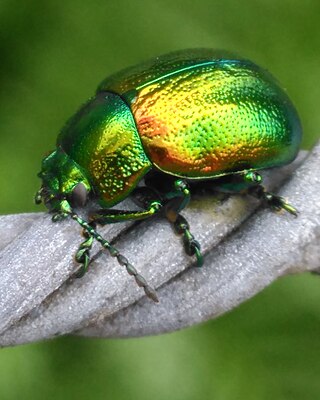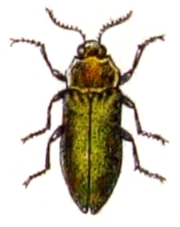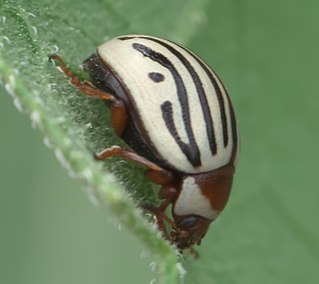
Hypericum perforatum, known as St. John's wort, is a flowering plant in the family Hypericaceae and the type species of the genus Hypericum.

Hypericum is a genus of flowering plants in the family Hypericaceae. The genus has a nearly worldwide distribution, missing only from tropical lowlands, deserts and polar regions. Many Hypericum species are regarded as invasive species and noxious weeds. All members of the genus may be referred to as St. John's wort, and some are known as goatweed. The white or pink flowered marsh St. John's worts of North America and eastern Asia are generally accepted as belonging to the separate genus TriadenumRaf.

The Tansy beetle is a species of leaf beetle. The common name derives from its main foodplant, Tansy, but it can also use other wetland plants such as Gypsywort and Water Mint. It measures 7.7–10.5 mm in length and has a characteristic bright metallic green colouration, with pitted elytra and a coppery tinge. In addition to the nominotypical subspecies, which repeats the specific name, C. graminis graminis, there are five further distinct subspecies of Tansy beetle, which, collectively, have a Palearctic distribution, although in the majority of countries where it is found the species is declining. In the United Kingdom it is designated as 'Nationally Rare'. The stronghold population here is located along the banks of the river Ouse in York, North Yorkshire. Other, small, fenland populations exist at Woodwalton Fen and at Welney Wildfowl and Wetlands Trust (WWT) reserve.

Phyllophaga is a very large genus of New World scarab beetles in the subfamily Melolonthinae. Common names for this genus and many other related genera in the subfamily Melolonthinae are May beetles, June bugs, and July beetles. They range in size from 12 to 35 mm and are blackish or reddish-brown in colour, without prominent markings, and often rather hairy ventrally. These beetles are nocturnal, coming to lights in great numbers.

The Chrysomelinae are a subfamily of leaf beetles (Chrysomelidae), commonly known as broad-bodied leaf beetles or broad-shouldered leaf beetles. It includes some 3,000 species around the world.
Aphthona cyparissiae is a species of leaf beetle known as the brown dot leafy spurge flea beetle. It is used as an agent of biological pest control against the noxious weed leafy spurge.
Aphthona czwalinae is a species of leaf beetle known as the black leafy spurge flea beetle. It is used as an agent of biological pest control against the noxious weed leafy spurge.

Agrilus hyperici, the St. John's wort root borer, is a species of jewel beetle. It is used as an agent of biological pest control against common St. John's wort in areas where it is a noxious weed or invasive species.

Xanthogaleruca luteola, commonly known as the elm-leaf beetle, is a beetle species in the family Chrysomelidae that is native to Europe but invasive in other parts of the world.

The striped flea beetle is a small flea beetle, shiny black with a greenish tinge, 1.5 to 2.5 mm long, having a wavy amber line running the length of each elytron. It is a pest of cabbage and other brassicas. The hind legs are thickened, enabling the beetle to jump like a flea when disturbed.

Chrysolina is a large genus of leaf beetles in the subfamily Chrysomelinae. Most species are distributed in Europe, Asia and Africa with a small number of species inhabiting North America and introduced species in Australia.

Chrysolina hyperici, the Saint John's Wort Beetle is a species of beetles of the family Chrysomelidae.

Galeruca tanaceti is a species of leaf beetle found in the Palearctic realm, and is the type species of the genus Galeruca. It was first described by Carl Linnaeus in his 1758 10th edition of Systema Naturae.

Oxyops vitiosa is a species of weevil in the family Curculionidae. Common names include the melaleuca leaf weevil and the melaleuca snout beetle. It feeds on the leaves and shoots of the broad-leaved paper bark tree, Melaleuca quinquenervia, which is endemic to Australia where it grows on seasonally inundated plains and swampland, and was introduced into Florida in order to help drain flooded portions of the Everglades.

Lebia grandis is a ground beetle in the family Carabidae found in North America. It is a specialist predator on the eggs and larvae of Colorado potato beetles, and its larvae are obligate parasitoids of Colorado potato beetle pupae.

Hylobius transversovittatus is a species of weevil in the family Curculionidae. It is native to the Old World where both adults and larvae feed on purple loosestrife. This plant is regarded as an invasive species in North America and the weevil has been introduced into both the United States and Canada in an effort to control the plant.

Galerucella calmariensis is a species of leaf beetle in the family Chrysomelidae. It is commonly known as the black-margined loosestrife beetle and is native to Europe and Asia where both adults and larvae feed on purple loosestrife. It has been introduced in North America as a biological control agent for purple loosestrife.

Cyclocephala borealis, the northern masked chafer, is a beetle in the family Scarabaeidae. It is native to North America, where it is considered a crop pest.

Zygogramma exclamationis, commonly known as the sunflower beetle, is a species of leaf beetle belonging to the family Zygogramma. It is regarded as a pest of sunflower crops in North America.

Aulacophora foveicollis, the red pumpkin beetle, is a species of beetle in the family Chrysomelidae. It is a foliar pest of members of the Cucurbitaceae, particularly the pumpkin. It is also a pest of millets in India.

















